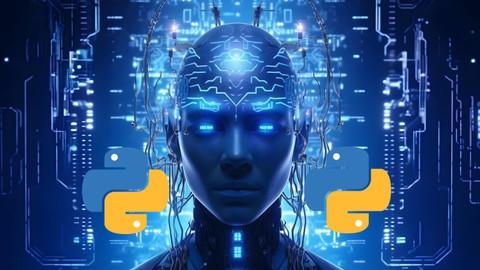Last Updated on July 2, 2024 by GeeksGod
Course : Data Science, AI, Machine Learning with Python
A warm welcome to the Data Science, Artificial Intelligence, and Machine Learning with Python course by Uplatz.
Data Science
Data Science is an interdisciplinary field focused on extracting knowledge and insights from structured and unstructured data. It involves various techniques from statistics, computer science, and information theory to analyze and interpret complex data.
Key Components:
Data Collection: Gathering data from various sources.Data Cleaning: Preparing data for analysis by handling missing values, outliers, etc.Data Exploration: Analyzing data to understand its structure and characteristics.Data Analysis: Applying statistical and machine learning techniques to extract insights.Data Visualization: Presenting data in a visual context to make the analysis results understandable.
Python in Data Science
Python is widely used in Data Science because of its simplicity and the availability of powerful libraries:
Pandas: For data manipulation and analysis.NumPy: For numerical computations.Matplotlib and Seaborn: For data visualization.SciPy: For advanced statistical operations.Jupyter Notebooks: For interactive data analysis and sharing code and results.
Artificial Intelligence (AI)
Artificial Intelligence is the broader concept of machines being able to carry out tasks in a way that we would consider “smart.” It includes anything from a computer program playing a game of chess to voice recognition systems like Siri and Alexa.
Key Components:
Expert Systems: Computer programs that emulate the decision-making ability of a human expert.Natural Language Processing (NLP): Understanding and generating human language.Robotics: Designing and programming robots to perform tasks.Computer Vision: Interpreting and understanding visual information from the world.
Python in AI
Python is preferred in AI for its ease of use and the extensive support it provides through various libraries:
TensorFlow and PyTorch: For deep learning and neural networks.OpenCV: For computer vision tasks.NLTK and spaCy: For natural language processing.Scikit-learn: For general machine learning tasks.Keras: For simplifying the creation of neural networks.
Machine Learning (ML)
Machine Learning is a subset of AI that involves the development of algorithms that allow computers to learn from and make predictions or decisions based on data. It can be divided into supervised learning, unsupervised learning, and reinforcement learning.
Key Components:
Supervised Learning: Algorithms are trained on labeled data.Unsupervised Learning: Algorithms find patterns in unlabeled data.Reinforcement Learning: Algorithms learn by interacting with an environment to maximize some notion of cumulative reward.
Python in Machine Learning
Python is highly utilized in ML due to its powerful libraries and community support:
Scikit-learn: For implementing basic machine learning algorithms.TensorFlow and PyTorch: For building and training complex neural networks.Keras: For simplifying neural network creation.XGBoost: For gradient boosting framework.LightGBM: For gradient boosting framework optimized for speed and performance.
Python serves as a unifying language across these domains due to:
Ease of Learning and Use: Python’s syntax is clear and readable, making it accessible for beginners and efficient for experienced developers.Extensive Libraries and Frameworks: Python has a rich ecosystem of libraries that simplify various tasks in data science, AI, and ML.Community and Support: A large and active community contributes to a wealth of resources, tutorials, and forums for problem-solving.Integration Capabilities: Python can easily integrate with other languages and technologies, making it versatile for various applications.
Artificial Intelligence, Data Science, and Machine Learning with Python – Course Curriculum
1. Overview of Artificial Intelligence, and Python Environment SetupEssential concepts of Artificial Intelligence, data science, Python with Anaconda environment setup
2. Introduction to Python Programming for AI, DS and MLBasic concepts of python programming
3. Data ImportingEffective ways of handling various file types and importing techniques
4. Exploratory Data Analysis & Descriptive StatisticsUnderstanding patterns, summarizing data
5. Probability Theory & Inferential StatisticsCore concepts of mastering statistical thinking and probability theory
6. Data VisualizationPresentation of data using charts, graphs, and interactive visualizations
7. Data Cleaning, Data Manipulation & Pre-processingGarbage in – Garbage out (Wrangling/Munging): Making the data ready to use in statistical models
8. Predictive Modeling & Machine Learning
Set of algorithms that use data to learn, generalize, and predict
1. Overview of Data Science and Python Environment Setup
Overview of Data ScienceIntroduction to Data ScienceComponents of Data ScienceVerticals influenced by Data ScienceData Science Use cases and Business ApplicationsLifecycle of Data Science ProjectPython Environment SetupIntroduction to Anaconda DistributionInstallation of Anaconda for PythonAnaconda Navigator and Jupyter NotebookMarkdown Introduction and ScriptingSpyder IDE Introduction and Features
2. Introduction to Python Programming
Variables, Identifiers, and OperatorsVariable TypesStatements, Assignments, and ExpressionsArithmetic Operators and PrecedenceRelational OperatorsLogical OperatorsMembership OperatorsIterables / ContainersStringsListsTuplesSetsDictionariesConditionals and Loopsif elseWhile LoopFor LoopContinue, Break and PassNested LoopsList comprehensionsFunctionsBuilt-in FunctionsUser-defined functionNamespaces and ScopeRecursive FunctionsNested functionDefault and flexible argumentsLambda functionAnonymous function
3. Data Importing
Flat-files dataExcel dataDatabases (MySQL, SQLite…etc)Statistical software data (SAS, SPSS, Stata…etc)web-based data (HTML, XML, JSON…etc)Cloud hosted data (Google Sheets)social media networks (Facebook Twitter Google sheets APIs)
4. Data Cleaning, Data Manipulation & Pre-processing
Handling errors, missing values, and outliersIrrelevant and inconsistent dataReshape data (adding, filtering, and merging)Rename columns and data type conversionFeature selection and feature scalinguseful Python packagesNumpyPandasScipy
5. Exploratory Data Analysis & Descriptive Statistics
Types of Variables & Scales of MeasurementQualitative/CategoricalNominalOrdinalQuantitative/NumericalDiscreteContinuousIntervalRatioMeasures of Central TendencyMean, median, mode,Measures of Variability & ShapeStandard deviation, variance, and Range, IQRSkewness & KurtosisUnivariate data analysisBivariate data analysisMultivariate Data analysis
6. Probability Theory & Inferential Statistics
Probability & Probability DistributionsIntroduction to probabilityRelative Frequency and Cumulative FrequencyFrequencies of cross-tabulation or Contingency TablesProbabilities of 2 or more EventsConditional ProbabilityIndependent and Dependent EventsMutually Exclusive EventsBayes’ Theorembinomial distributionuniform distributionchi-squared distributionF distributionPoisson distributionStudent’s t distributionnormal distributionSampling, Parameter Estimation & Statistical TestsSampling DistributionCentral Limit TheoremConfidence IntervalHypothesis Testingz-test, t-test, chi-squared test, ANOVAZ scores & P-ValuesCorrelation & Covariance
7. Data Visualization
Plotting Charts and GraphicsScatterplotsBar Plots / Stacked bar chartPie ChartsBox PlotsHistogramsLine Graphsggplot2, lattice packagesMatplotlib & Seaborn packagesInteractive Data VisualizationPlot ly
8. Statistical Modeling & Machine Learning
RegressionSimple Linear RegressionMultiple Linear RegressionPolynomial regressionClassificationLogistic RegressionK-Nearest Neighbors (KNN)Support Vector MachinesDecision Trees, Random ForestNaive Bayes ClassifierClusteringK-Means ClusteringHierarchical clusteringDBSCAN clusteringAssociation Rule MiningAprioriMarket Basket AnalysisDimensionality ReductionPrincipal Component Analysis (PCA)Linear Discriminant Analysis (LDA)Ensemble MethodsBaggingBoosting
9. End to End Capstone Project














